Unlock John Lee Hooker's Blues Guitar Tricks With This "Dimples" Guitar Lesson
One of the secrets to John Lee Hooker’s sound is how he played fingerstyle on electric guitar. Today I’ll break down some of his exact techniques in this “Dimples” guitar lesson.
The combination of fingertips and electric guitar with a bit of breakup to the sound is a magical tone for blues guitar. There are two main sections we are going to cover in this lesson, the blues groove and an 8-bar blues chord progression. So tuneup, and let’s get started!
Who wrote Dimples?
"Dimples" was written by blues legend John Lee Hooker. The original version featured Jimmy Reed’s backup band. John Lee Hooker played the riff on slide guitar in the original version.
Dimples Chords
“Dimples” is in the key of E and uses just 3 chords E7, A7, and B7. These 3 chords are 3 most common chords in blues tunes and are often referred to as the I, IV, and V chords in the key.
E7 = I chord
A7 = IV chord
B7 = V chord
Also, check out how all the chords are dominant 7th chords. This is noted by the 7 after the letter name of each chord. Here is how I would play these 3 shapes.
E7 I would play like this:
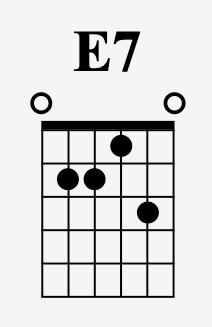
A7 has a root on the 5th string and goes like this:
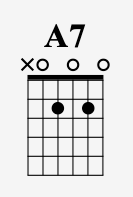
And finally, B7 goes like this:

Blues Groove
A huge part of playing this song is all about just grooving on an E7 chord. As I mentioned above a key ingredient to the sound is to not use a pick and just play the part with your fingers.
Now you can play it with a pick just the same however, the tone will change quite a bit when you use your fingers.
A lot of early blues players played fingerstyle or even used a thumbpick quite a bit.
Start by making the E7 chord shape and pluck the low 6th string with your thumb and then do an upstrum on the rest of the chord with your index finger like this:

It’s important to note that blues fingerstyle is different from classical or folk styles of fingerpicking. Blues players often used more of a brushing style where the fingers strummed the strings as well as plucked individual ones. This groove is an example of that style.
After the E7 chord well rest, and then play the 2nd fret on the 5th string, and then open 4th string to the 2nd fret like this:
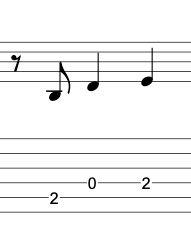
Next, try putting these parts together and repeating this groove like this:

Fingerpicking hand tip: My approach with the fingerpicking hand is to just use my thumb and my index fingers to play the groove. The thumb plays the down beats and the index plays anything on the upbeats. This is one of the approaches that I detail in my Essential Fingerstyle Guitar style, on how to approach strumming without a pick.
Once this groove starts to feel comfortable feel free to play with the rhythms a bit. This is where you can start to improvise with the rhythms in the groove.
The idea is to take the basic rhythm and play it along with the song, but once it starts to feel comfortable experiment.
Here is an example of another rhythm you could play over the E7 chord.
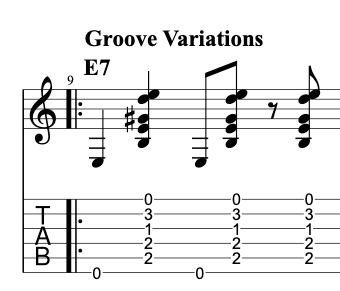
Start by making an E7 chord shape. Play the 6th string open on beat 1, and then the rest of the chord on beat 2.
These are both done with the fingerpicking hand thumb like this:
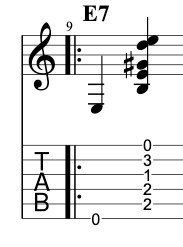
Then on beat 3, we’ll again play the bass note and the rest of the chord just like beat 1 in the first groove. Then on beat 4, we’ll rest and finish with an upstrum on the E7 chord using the index finger. This groove variation still follows the same thumb and index rhythm pattern of the thumb playing the downbeats while the index plays the upbeats.
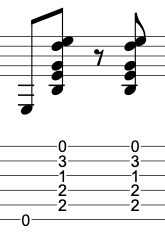
Scales:
The primary scale that Hooker uses in this song is the E minor blues scale. This pattern can be played in open position like this:
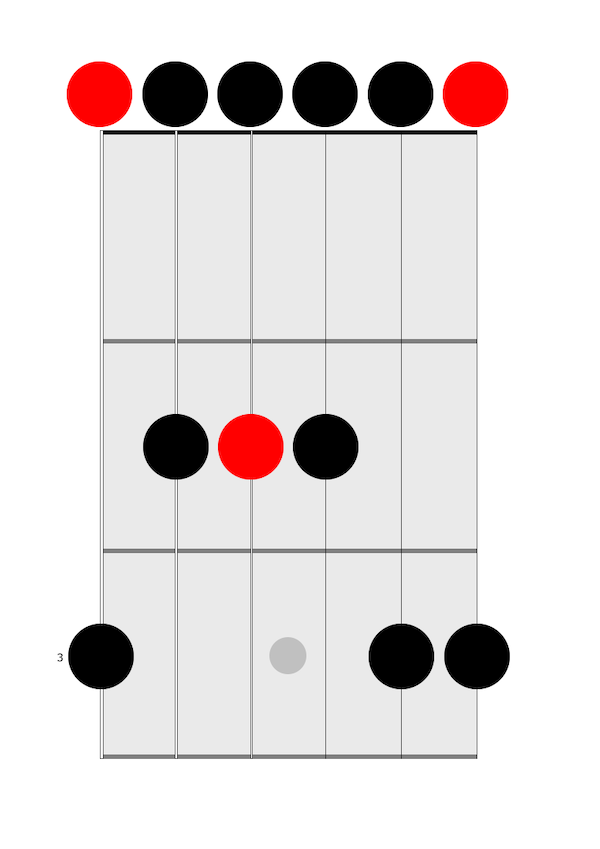
Those same strings and frets can be viewed like this as well:
6th string = 0, 3
5th string = 0, 1, 2
4th string = 0, 2
3rd string = 0, 2, 3
2nd string = 0, 3
1st string = 0, 3
For more on Hooker’s soloing style check out this lesson
8-bar blues
Aside from the groove on the E7 chord, the majority of “Dimples” follows an 8-bar blues chord progression that goes like this:
E7 (4 bars)
A7 (1 bar)
B7 (1 bar)
E7 (2 bars)
Wherever there is an E7 in the above chord progression I play the groove from above. Let’s next look at a rhythm approach for the A7 and B7 chords
For A7 I’ll play the open 5th string on beat 1. For beat 2 I’ll strum the rest of the A7 chord. Beat 3 I’ll play a down and upstrum (thumb-index), and then finally one last downstrum on beat 4 like this:
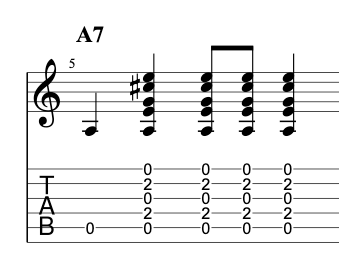
I use the same rhythm for the B7 in bar 6 I just switch the chord shape in the fretting hand and play this:
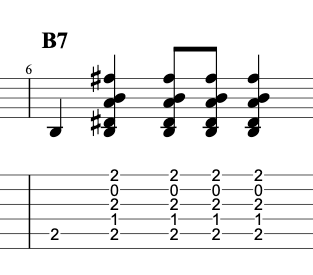
I count it using eighth notes like this:
D D D U D
1 + 2 + 3 + 4 +
The A7 to the B7 functions as a turnaround progression to take us back to the top. However, this is an interesting twist because usually, you would go the opposite direction so for example, B7 to A7 in a blues in the key of E. But this progression flips it.
How to Get a John Lee Hooker Style Guitar Tone
Hooker had a legendary blues guitarist tone. As I mentioned above one of the key ingredients was his fingerstyle approach on electric guitar.
While getting his exact tone can be challenging, I can provide you with some general guidelines to help you achieve a similar blues guitar tone. Here are some tips:
- Guitar and Amp: Start with a guitar that has humbucker pickups. Hooker primarily played humbucker-style guitar. As for the amplifier, a classic tube amp like a Fender Deluxe Reverb can help you achieve a warm and vintage blues tone.
- Equalization (EQ): Set your amp's EQ settings to emphasize the midrange frequencies. Boosting the mids and slightly rolling off the treble and bass can give you a tone that cuts through the mix and has a characteristic bluesy sound. Roll the volume back a little on the guitar itself and dial in the tone with it rolled back. Experiment with the settings to find the sweet spot that suits your guitar and amp combination.
- Gain and Distortion: John Lee Hooker's tone was generally characterized by a clean or slightly overdriven sound. You can achieve this by keeping the gain or distortion relatively low on your amp. Use the natural breakup of the tubes to add a touch of grit to your sound without it becoming too distorted. If you need more gain, consider using a mild overdrive pedal to add a bit of crunch while maintaining clarity. (This is what I did in the video above)
- Technique: Hooker's playing style was often characterized by a raw and percussive approach. He used a lot of slide guitar techniques, so incorporating a slide can help you achieve a more authentic sound. Also, fingerstyle on electric is the secret sauce as mentioned.
- Dynamics and Feel: John Lee Hooker's blues had a lot to do with the dynamics and feel he brought to his playing. Experiment with your technique to emphasize the dynamics by varying your attack and using your fingers instead of a pick for a more organic sound. Hooker's playing often had a loose and relaxed feel, so try to capture that in your own playing.
- Room Ambience: Hooker's recordings often featured a raw, live sound with some room ambience. If you're recording, consider experimenting with microphone placement and room acoustics to capture a more authentic and live vibe. Add a touch of reverb to create this in a small room.
Remember, achieving an exact replica of John Lee Hooker's tone can be challenging, as it was influenced by various factors like his guitar, amplifier, recording techniques, and personal style. However, by incorporating these guidelines and adding your own personal touch, you can capture the essence of his blues guitar tone and create a sound that suits your style.
Conclusion:
Learning to play "Dimples" by John Lee Hooker on guitar not only provides a great opportunity to dive into a classic blues tune but also allows us to appreciate and emulate Hooker's unique style.
His raw and emotive approach to the blues, characterized by a distinctive guitar tone and rhythmic simplicity, has influenced countless musicians.
As we've explored the various techniques and elements that make up Hooker's style, from his percussive fingerpicking to his use of the blues scale, we gain a deeper understanding of the blues and its expressive power. By incorporating these techniques into our own playing, we reap big benefits in our musicianship and sound.
Remember, it's not just about replicating every note and nuance of Hooker's performance but about capturing the essence of his playing. So have fun practicing this timeless blues classic and for another John Lee Hooker lesson check out “Boom, Boom” or “Boogie Chillen Blues” next!
Like this blog post? Get Jon’s best guitar lessons straight to your inbox.
